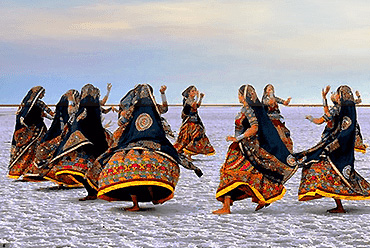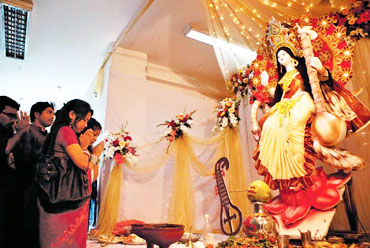The full moon day of April/May is celebrated as the birthday of Gautam Buddha, the founder of Buddhism. This day holds special importance for the follower of Buddhism, as it is believed that on this day Lord Buddha was born, got enlightenment and also attained nirvana or salvation. The Buddha is regarded as the ninth incarnation of Lord Vishnu.
Celebrations
All the important occasions related to the Buddha are combined in one on the full moon day in Vaishakh. Prayers, sermons, and non-stop recitation of Buddhist scriptures resonate in monasteries, religious halls, and homes. In the monasteries in Sikkim, monks hold daylong reading of the scriptures before the Buddha's statue. The lay people listen to these recitals, and also offer gifts to the monks and the statue.
The statue of the Buddha receives special attention everywhere, with people offering it incense, flowers, candles, and fruits. The Bodhi Vriksha or the pipal tree the under which the Buddha's attained enlightenment also receives a fair share of garlands and colored flags. People also sprinkle milk and scented waters on its roots and light lamps around it.
Rituals
Buddhist rituals for celebrating the three-in-one occasion are naturally elaborate. The day falls in the Vaishakh month according to the Indian solar calendar. For the Tibetans, it is the full moon day in the fourth month of the Tibetan calendar.
On this day the Buddhists bathe and wear only white clothes. They gather in their viharas for worship and give alms to monks. Many spend their entire day at the vihara listening to discourses on the life and teachings of the Buddha or invite monks to their homes. They also reaffirm their faith in the five principles called Panchsheel-not to take life, not to steal, not to lie, not to imbibe liquor or other intoxicants, and not to commit adultery.
On Buddha Purnima, Buddhists refrain from eating meat and eat kheer or rice cooked in milk and sugar, which they share with the poor. They set up stalls in public places to offer others clean drinking water and also show kindness to animals.
Legends
Legend has it that on the full moon day of Vaishakh 544 BC, the Buddha's mother, Queen Mahamaya, happened to be on her way from the capital Kapilavastu to her parents' home in Devdaha. During the journey she stopped under the shade of two sal trees at Lumbini, where she gave birth to the Buddha. When she returned to Kapilavastu, an old sanyasi named Asit, who was also the court astrologer, came to the palace and predicted that the child would redeem the world.
The child was named Siddhartha. But even after enlightenment he was better known by his clan name-Gautam the Buddha or Gautam the wise. Gautam was brought up by his mother's sister who was also his stepmother as his mother died soon after his birth.
Gautam was a serious-minded child who instead of playing with other children would sit alone, lost in his own thoughts. When Prince Gautam came of age, his father arranged his marriage to the beautiful Princess Yashodhara and saw to it the prince was kept occupied with diverse amusements and pleasures of life. None of these, however, succeeded in diverting Gautam's mind from its quest for truth.
Though Prince Gautam was a Kshatriya, he never hunted and instead tried to protect animals and birds. There were other things about the world that began to trouble Gautam. One day, when passing through a street, he saw a man who was so old that he could not walk. Another day, he saw a very sick man lying unconscious on the ground. He asked himself, "What is pain? Why is there so much pain and suffering in the world? Is there a way of avoiding these?"
Then Gautam came across an ascetic who looked so calm that he seemed to have found the answers to the problems of old age, sickness and death. Gautam decided to renounce the world and become an ascetic. He discarded his royal robes, snipped off his long curling tresses and went out into the dark night to seek the light of knowledge.
Gautam went from one religious center to another and from one hermitage to the next seeking in vain answers to his questions. Finally in a forest at the edge of the river Niranjana near Gaya, Gautam practiced meditation and penance for six years yet nothing happened. He then realized that enlightenment could not come through mortifying the flesh. That very day a woman named Sujata offered him a bowl of kheer and a grass cutter gave him a stack of grass to sleep on. Gautam accepted both these gifts. He then took his seat under a Bodhi tree and resolved to stay there until he found the answers to his questions.
One Vaishakh full moon night, he found the answers to the four truths of life-the existence of pain and suffering, their causes, the need to overcome them and the means of doing so. Thus, he became Gautam the Buddha or the Enlightened One on his thirty-fifth birthday.
From Gaya, the Buddha proceeded to Sarnath near Varanasi. Here five men became his disciples. He taught them the truths he had discovered and formed the first sangh or community. Thereafter, he traveled far and wide preaching the truth and gained a large following consisting of scholars, sanyasis, kings and their ministers. He also went to his home as a bhikshu or monk. His father, stepmother, wife and son joined his sangh. In 483 BC, on the same day that he was born, and had attained enlightenment, the Buddha attained nirvana.
Regional Celebrations
Bodh Gaya in Bihar and Sarnath in Uttar Pradesh are the main centers of celebration of this festival. Besides these two, areas with large Buddhist population like Ladakh, Sikkim, and Arunachal Pradesh also celebrate this festival with great devotion and enthusiasm.
Places To Visit
Bodh Gaya in Bihar and Sarnath in Uttar Pradesh are some of the places to visit during this festival. One can see the various celebrations and related rituals, to observe which Buddhists from all over the world congregate at these places.




